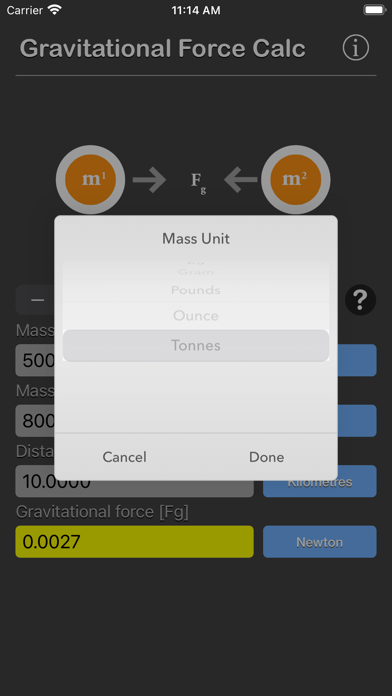
Gravitational Force Calculator
The Gravitational Force Calculator is a physics/math calculator that calculates the gravitational force between two objects, considering their mass and the distance between them.
Features:
- Instant calculation
- Results are copyable to other apps
- Formulas are included as references
- Supports up to 16 decimal places
- Supports various units for each input
Newton’s Law of Gravity states that every point mass attracts every single other point mass by a force pointing along the line intersecting both points. This Newton’s Law of Gravity Calculator is used to calculate and find the gravitational force between two objects, considering their mass and the distance between them.
Formulas:
1. Gravitational Force:
F = Gm₁m₂/ r²
2. Mass of Object 1:
m₁ = Fr² /Gm₂
3. Mass of Object 2:
m₂ = Fr²/ Gm₁
4. Distance between the Objects:
r = √(Gm₁ m₂/F)
Where,
G = Universal Gravitational Constant = 6.6726 x 10⁻¹¹N-m²/kg²
m₁ = Mass of Object 1
m₂ = Mass of Object 2
r = Distance Between the Objects.
Gravity, or gravitation, is a natural phenomenon by which all things with mass are brought toward (or gravitate toward) one another, including objects ranging from electrons and atoms to planets, stars, and galaxies. Since energy and mass are equivalent, all forms of energy (including photons and light) cause gravitation and are under its influence. On Earth, gravity gives weight to physical objects, and the Moons gravity causes ocean tides. The gravitational attraction of the original gaseous matter present in the Universe caused it to begin coalescing, forming stars – and for the stars to group together into galaxies – so gravity is responsible for many of the large-scale structures in the Universe. Gravity has an infinite range, although its effects become increasingly weaker on farther objects.
Gravity is most accurately described by the general theory of relativity (proposed by Albert Einstein in 1915), which describes gravity not as a force but as a consequence of the curvature of spacetime caused by the uneven distribution of mass. The most extreme example of this curvature of spacetime is a black hole, from which nothing—not even light—can escape once past the black holes event horizon. However, for most applications, gravity is well approximated by Newtons law of universal gravitation, which describes gravity as a force that causes any two bodies to be attracted to each other, with the force proportional to the product of their masses and inversely proportional to the square of the distance between them.
Thanks for your support, and do visit nitrio.com for more apps for your iOS devices.



